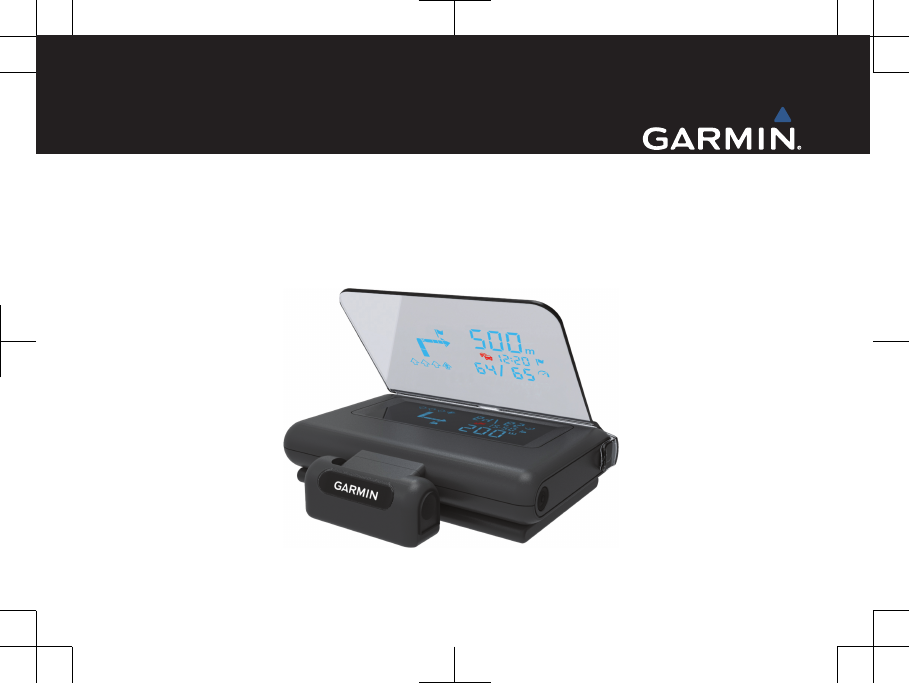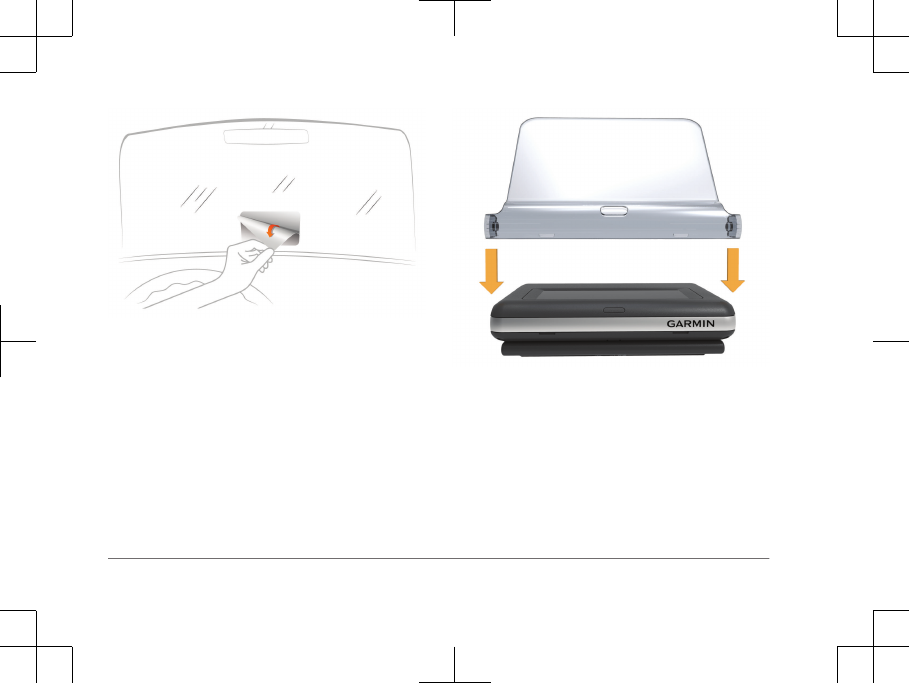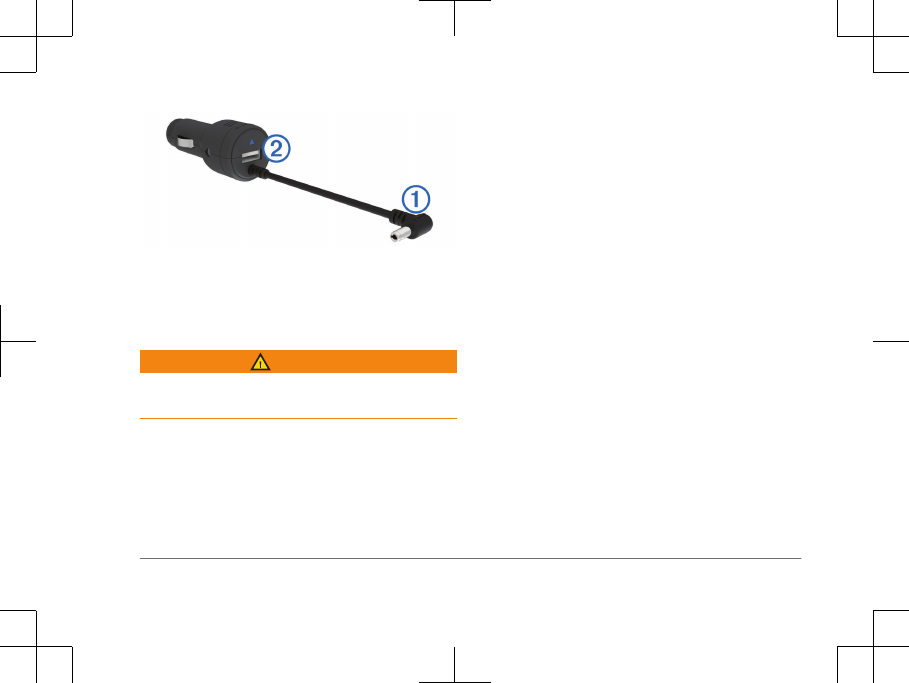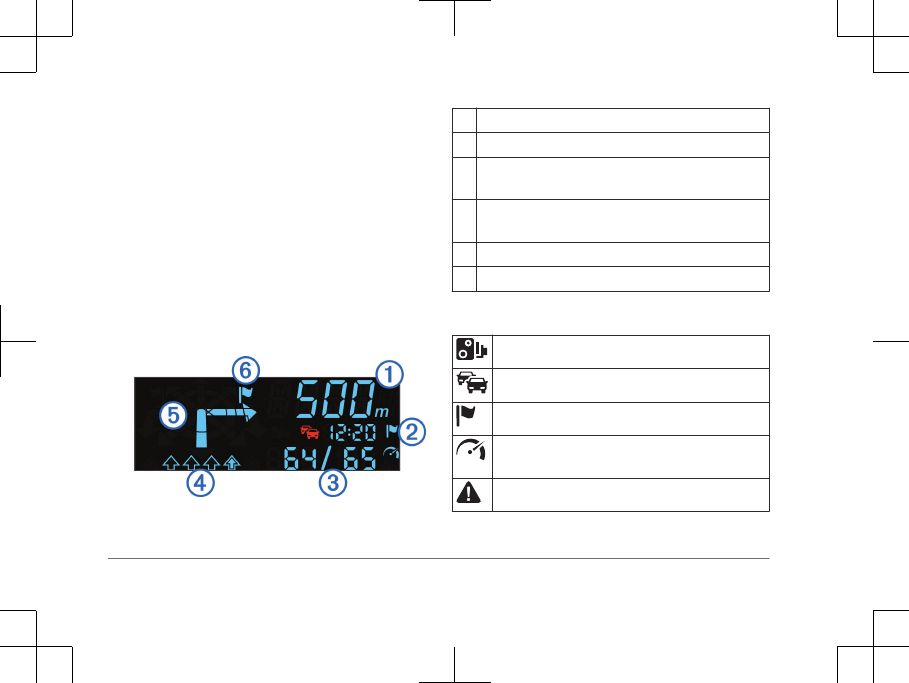Users Manual

Garmin® HUD
Quick Start Manual
June 2013 190-01608-00_0A Printed in Taiwan
DRAFT

Getting Started
WARNING
See the Important Safety and Product
Information guide in the product box for product
warnings and other important information.
Device Placement Considerations
WARNING
Failure to observe the following device
placement considerations could result in an
accident or collision resulting in death or serious
injury.
• Place the device securely on the dashboard.
•Do not place your smartphone on the
dashboard of the vehicle.
• Do not place the device so that it obstructs
the driver's view of the road. The reflector
lens and film can be placed in the driver's
field of vision.
• Do not place the device where it or the cable
will interfere with vehicle operating controls.
• Do not place the device in front of or above
any airbags.
• Test the device and film placement before
applying the film. After the film is dry, it
cannot be moved.
Applying the Film to the Windscreen
NOTICE
Before applying the film to the window, check
laws and ordinances in the area where you
drive. Some laws prohibit or restrict the
application of film to the front window. It is your
responsibility to apply the film in compliance
with all applicable laws and ordinances. Garmin
is not responsible for any fines, penalties, or
damages that may be incurred as a result of any
2
DRAFT

law or ordinance relating to the use of your
Garmin device.
Do not apply the film to a dry surface. If you
apply the film to a dry surface and try to remove
the bubbles, the film will be ruined.
NOTE: Before applying the film, test the location
with the device turned on. You cannot move the
film after it is applied and has dried.
You can use the included film to reflect the
display onto the windscreen.
1Select a location to apply the film.
The film should be in the driver's view,
preferably in the center of the field of vision.
2Clean and dry the windscreen with a lint-free
cloth.
3Spray clean water on the windscreen.
The water enables the film to attach to the
window.
4Pull the tab labeled 1 to remove the
protective layer from the adhesive side of
the film.
5Apply the film to the window, with the
protective layer 2 facing out.
6If necessary, move the film to the ideal
viewing location while the windscreen is still
wet.
7Use a card to scrape the bubbles out to the
edge of the film.
Only remove the bubbles with the top layer
on the film.
The fewer bubbles in the film, the better the
view of the data.
8Wait three to five days for the film to dry.
TIP: You can use the reflector lens while you
are waiting for the film to dry.
9Pull the tab labeled 2 to remove the final
protective layer from the film.
3
DRAFT

Connecting the Reflector Lens
You can use the snap-on reflector lens instead
of the windscreen film. This allows you to use
the head-up display in other vehicles or in areas
where the film is not permitted.
Snap the reflector lens onto the device.
Connecting to Vehicle Power
You can charge a smartphone device using the
USB port on the vehicle power connector.
1Plug the vehicle power cable into a power
outlet in your vehicle.
2Plug the other end of the device power cable
À to the small hole on the device.
4
DRAFT

3If necessary, plug the smartphone power
cable into the USB port Á.
Placing the Device on the Dashboard
WARNING
When placing the device in a vehicle, observe
all placement considerations listed previously.
1Select a location for the device (page 2).
2Clean and dry the dashboard where you are
placing the device.
3Place the device on the dashboard.
4Press the base down.
The base conforms to the shape of the
dashboard.
5Adjust the viewing angle as needed.
If the bottom surface of the device slides on the
dashboard due to dust and dirt buildup, wipe it
clean using a wet cloth.
Connecting the Device to Your
Smartphone
Before you can use the head-up display, you
must connect it to your smartphone.
1Plug in the device and ensure it is turned on.
2Bring the smartphone and the device within
33 ft. (10 m) of each other.
3On the smartphone, enable Bluetooth®
wireless technology and search for devices.
A list of nearby Bluetooth devices appears.
4Select the head-up display in the list.
5
DRAFT

If automatic detection of paired devices is
enabled on your smartphone, the device
automatically connects to the smartphone every
time they are both turned on and within range of
each other.
Navigation
Display While Navigating
After you create a route on your smartphone
and compatible app, the device displays routing
information on the windscreen or reflector lens.
ÀDistance to the next turn
ÁTime to reach the destination.
ÂCurrent speed and the posted speed limit, when
available
ÃLane of travel (filled in arrow indicates proper
lane)
ÄDirection of the next turn
ÅSide of the street the destination is
Status Icons
Nearby safety camera
Traffic
Destination
Current speed and the posted speed limit,
when available
Vehicle exceeding the speed limit
6
DRAFT

Specifications
Operating temperature
range
-15° to 70°C (5° to 158°F)
Storage temperature
range
-40° to 85°C (-40° to
185°F)
Operating voltage and
current
10–28 Vdc (OVP @
30 Vdc); typically 12 Vdc,
1.5 Amp and 24 Vdc,
0.8 Amp
USB port voltage 5 Vdc
USB port current 2.1 Amp
7
DRAFT

www.garmin.com/support
913-397-8200
1-800-800-1020
0808 238 0000
+44 870 850 1242 1-866-429-9296 +43 (0) 820 220 230
+32 2 672 52 54 +45 4810 5050 +358 9 6937 9758 + 331 55 69 33 99
+49 (0)180 6 427646 + 39 02 36 699699 0800 - 023 3937
035 - 539 3727 + 47 815 69 555
00800 4412 454
+44 2380 662 915 + 35 1214 447 460 + 34 93 275 44 97 + 46 7744 52020
Garmin International, Inc.
1200 East 151st Street
Olathe, Kansas 66062, USA
Garmin (Europe) Ltd.
Liberty House, Hounsdown Business Park
Southampton, Hampshire, SO40 9LR UK
Garmin Corporation
No. 68, Zhangshu 2nd Road, Xizhi Dist.
New Taipei City, 221, Taiwan (R.O.C.)
Garmin® and the Garmin logo are trademarks of Garmin Ltd. or its subsidiaries,
registered in the USA and other countries. These trademarks may not be used
without the express permission of Garmin. Other trademarks and trade names are
those of their respective owners.
© 2013 Garmin Ltd. or its subsidiaries
DRAFT
Notice
This device complies with Part 15 of the FCC Rules. Operation is subject to the
following two
conditions: (1) this device may not cause harmful interference and (2) this
device must accept any interference received, including interference that may
cause undesired operation.
For P15B equipment
This equipment has been tested and found to comply with the limits for a Class
B digital device, pursuant to part 15 of the FCC rules. These limits are
designed to provide reasonable protection against harmful interference in a
residential installation. This equipment generates, uses and can radiate radio
frequency energy and, if not installed and used in accordance with the
instructions, may cause harmful interference to radio communications.
However, there is no guarantee that interference will not occur in a particular
installation. If this equipment does cause harmful interference to radio or
television reception, which can be determined by turning the equipment off and
on, the user is encouraged to try to correct the interference by one or more of
the following measures:
-Reorient or relocate the receiving antenna.
-Increase the separation between the equipment and receiver.
-Connect the equipment into an outlet on a circuit different from that to which
the receiver is connected.
-Consult the dealer or an experienced radio/TV technician for help.
This device is to be used only for mobile and fixed application.
FCC approvals the antenna(s) used for this transmitter must be installed to
provide a separation distance of at least 20 cm from all persons and must not
be co-located or operating in conjunctionwith any other antenna or transmitter.
If antenna is installed with a separation distance of less than 20 cm from all
persons or is co-located or operating in conjunction with any other antenna or
transmitterthen additional FCC testing may be required. End-Users must be
provided with transmitter operation conditions for satisfying RF exposure compliance.
Any changes or modifications not expressly approved by the party responsible for
compliance could void the user's authority to operate this equipment.